Smartphones are finally getting smart with AI chips inside them to drive improved virtual assistants, imaging and other applications. Processors are being sold with massive amounts of AI-based processing power, and there’s still all the power of the cloud to drive AI apps, allowing any business to make products and services genuinely smarter.
After years of tinkering around the edges, 2018 saw the arrival of some real AI power in consumer hardware. Yes, we already use AI a lot, in search, navigation and image processing, all invisible to the user. But, this marks the transition of AI from an enterprise toy for services or better business decisions to democratizing that power to enable better virtual assistants, chatbots, and casual features from even-better-looking photographs to improved predictive text and other benefits.
In January, the CES Show taking place in Las Vegas will tout endless products as having AI from fridges to ovens, cars to doorbells and so on. AI-powered Robo Services that can cook food, clean homes, and cater to shoppers will start to grow massively in use and reach.
But the real AI power will be in your smartphone with Samsung, Google and Apple all throwing dedicated AI hardware into their devices and the consumer services that will really make the best use of that power.
Mighty power in small packages
Apple’s Neural Engine, part of the A12 Bionic chip is already two generations old after debuting in the iPhone X. It is used for Face ID and a growing number of tasks. The performance leap in one generation has gone from 600 billion operations per second to a mighty 5 trillion per second, imagine what 2020’s models will do.
Google’s Tensor Processing Units have shrunk massively since being unveiled two years ago. They can now live on the edge of the Internet of Things in all sorts of devices, crunching numbers and making smart decisions or giving bosses actionable recommendations. And the company’s new Pixel 3 phone features its first AI processor, helping with call screening, music identification and more.
Nvidia’s Jetson Xavier chips are high-end AI processing cores, currently aimed at industrial use when linked to a range of sensors. But as with all processors, they’ll end up in consumer hardware to help drive us to work, monitor our health more accurately and so on. Featuring Volta Tensor Core GPU, eight-core ARM64 CPU, dual NVDLA deep learning accelerators, an image processor, a vision processor and a video processor, these packages on a chip can basically handle anything we currently need from AI.
And, among the features of the software tools is Isaac Sim, a virtual simulator environment for developers to train their autonomous machines and perform hardware testing with Jetson Xavier, making machine training and learning more direct and dynamic.
The “God Mode” AI-Powered Virtual Assistant
All of this raw power available in your hand, or smart devices is only as good as the applications that can use them, and now we’ve got the low-hanging fruit out of the way, with image apps, assistants and identifying things, it is time to move on. By 2020, AI will be better at predicting our needs, decision making on our behalf, interacting with other AIs and people for us, and automating ever more complex processes.
Chatbots will get smarter, and faster, not relying on the cloud or a wonky mobile connection. They will be able to link to other services, providing us with a greater range of responses or actions. And, they will merge more with our virtual assistants to provide an all-around package.
All predictions suggest huge growth and user acceptance for bots and VAs in all their forms from now to eternity, as they become part of the digital furniture. But what’s not being talked about is the big leap from a generalist AI-powered assistant or helper to one that really takes hold of our lives and helps in dozens of different ways each day.
Technology-adept users will likely welcome such a service. While, as with bots and any technology, there will be a long gap between those concerned about privacy, security and digital rights getting on-board. Yet within a few years, the bot that does all your bills transfers accounts to the best rates, books the cheapest tickets and keeps track of your family and friends could be all we need, and it’ll be powered by a few millimeters of silicon on your phone or smart home device.
